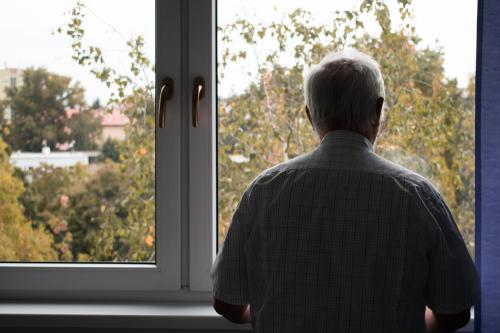Aging into older adulthood introduces many mental health stressors, such as physical decline, losses of loved ones, and reduced mental acuity. These stressors may lead to a diagnosable mental illness or result in frequent bouts of psychological distress that do not meet the criteria of a diagnosable illness. Regardless of clinical diagnosis, psychological distress can impair functioning for adults ages 65 and older. In The mental health landscape for older adults in the U.S., we extend the conception of the need for mental health care as stretching beyond using diagnosis as the principal indicator of need. We apply this perspective to analyze the need for mental health care and policy solutions to address the related sources of impairment faced by older adults.
Using a variety of rich data sources, we describe the state of mental health of older adults in the United States. We examine the following factors in depth:
- rates of diagnosis of mental illness;
- indicators of isolation, loneliness, and suicidal behavior;
- interconnections between symptoms of depression and functional impairments;1
- the association between symptoms of depression and economic circumstances; and
- markers of access to care.
There are disparities in rates of mental illness, SUD, and suicide among older adults
First, we examine the prevalence of mental illness and suicide among older adults.2 Rates of mental illness vary by demographic group. Non-Hispanic Black and lower income older adults are most likely to experience mental illness and substance use disorder (SUD). Women are more likely to experience mental illness, but men are more likely to experience SUD. The prevalence of mental illness remained relatively consistent between 2010 and 2019. Those ages 85 and older are most likely to experience symptoms of depression, while adults between ages 65 and 74 are most likely to experience alcohol use disorder (AUD). Across all age groups, men have significantly higher suicide rates than women. The most striking difference is between men and women ages 85 and older: women in this age group have the lowest suicide rate among all older adults, while men have the highest by a significant margin. Non-Hispanic older white adults also tend to have the highest suicide rate within our sample. There has been an uptick in suicides since the mid-to-late 2000s, particularly pronounced for men 85 and older since 2018. The difference in prevalence between mental illness and suicide reinforces the complex causes of suicide, where mental illness is one among several risk factors. Additionally, although we highlight rates of any mental illness (AMI), serious mental illness (SMI), symptoms of depression, SUD, and AUD, we emphasize the heavy burden that sub-clinical levels of psychological distress, meaning the experience of symptoms of a mental health condition that do not rise to the level of a diagnosis, also place on older adults.
Across all age groups, men have significantly higher suicide rates than women. The most striking difference is between men and women ages 85 and older: women in this age group have the lowest suicide rate among all older adults, while men have the highest by a significant margin.
Connections between mental health, functional impairment, and economic disadvantage can worsen the experience of aging
Social isolation, functional impairment, and financial insecurity appear to play a large role in the experience of poor mental health and psychological distress. Those with symptoms of depression are more likely to feel lonely often, are more likely to live alone, and have smaller social networks. Additionally, those with functional limitations, both activities of daily living (ADLs) and instrumental activities of daily living (IADLs), are more likely to have symptoms of depression and AUD. Rates of symptoms of depression increase as the degree of functional impairment increases. Prevalence of symptoms of depression is also highest among those in the lowest income and asset quintile. Those with symptoms of depression spend more of their income and save less. These patterns appear to be driven by the share of income spent on housing and food. We also examine the interaction between these stressors. Rates of symptoms of depression are highest among individuals with both lower income and functional limitation. Within levels of the income distribution, individuals with functional impairment have higher rates of symptoms of depression than those without. Yet, those at the top of the income distribution have lower rates of symptoms of depression than those with lower incomes regardless of disability level, indicating that higher levels of income likely afford greater access to supports which mitigate the negative effects of aging on autonomy and connection.
Barriers to accessing mental health care persist among older adults
Access to health insurance and mental health care varies among older adults. Individuals with past year SMI were most likely to be covered by Medicare alone. This implies that a significant share of people with a serious mental illness who are only covered by Medicare are likely to experience financial pressure due to their high level of treatment need. There are also disparities in access to care by demographic characteristics and medical diagnosis. Conditional on past year mental illness, female, non-Hispanic white, and higher income older adults were most likely to use mental health care. A larger share of individuals with SMI received care than the share for individuals with AMI. However, among all older adults who received mental health care in the past year, over half did not meet diagnostic criteria for mental illness. We interpret the large share of treatment resources used by people with sub-clinical levels of distress as, in part, a reflection of the complex influences on the mental well-being of older adults. The setting in which care is received also differs by markers of illness, severity, and complexity. Regardless of mental health status, care was accessed most heavily through telehealth services. Besides telehealth, private therapists are most often seen by older adults with depression or no diagnosis of a mental illness, compared to mental health clinics being utilized most by older adults with AMI, SMI, or depression with severe role impairment. In general, care for SUD is accessed at a significantly lower rate than care for mental illness. Among those with SUD that received treatment, the most common locations of care are inpatient or outpatient rehab facilities and self-help groups.
Overall, we find that the experience of mental health among older adults is wide-ranging. There are large racial, ethnic, gender, and income disparities in rates of mental illness, SUD, and suicide. Additionally, there is a significant connection between mental health, physical impairments, and economic disadvantage – all of which may exacerbate challenges related to aging. Many older adults with mental illness are not receiving treatment, suggesting barriers to accessing care such as underinsurance, financing, and stigma. In contrast, most older adults receiving care do not have a diagnosable mental health condition. Further attention must be paid to the disruptive effects of sub-clinical levels of psychological distress in older adults. Together, these observations suggest that mental health and the need for behavioral health services among older adults would benefit from a wider view than standards of care modeled for younger populations. Therefore, we recommend increased support to mitigate the stressors of aging and embedding flexibilities in insurance plans to address the mental health needs of older adults more adequately.
-
Acknowledgements and disclosures
The authors would like to thank Carol Graham for her review of an earlier draft and Caitlin Rowley for editorial assistance.
This work was supported by a grant from The SCAN Foundation.
The Brookings Institution is financed through the support of a diverse array of foundations, corporations, governments, individuals, as well as an endowment. A list of donors can be found in our annual reports published online here. The findings, interpretations, and conclusions in this report are solely those of its author(s) and are not influenced by any donation.
-
Footnotes
- Functional impairments are identified by activities of daily living (ADLs) and instrumental ADLs (IADLs), referring to more complex tasks associated with living independently.
- For further discussion of these issues, please see our previous work: Zilkha, Agarwal, and Frank, “Suicide Rates Are High And Rising Among Older Adults In The US,” Health Affairs Forefront. March 4, 2024. https://www.healthaffairs.org/content/forefront/suicide-rates-high-and-rising-among-older-adults-us









